
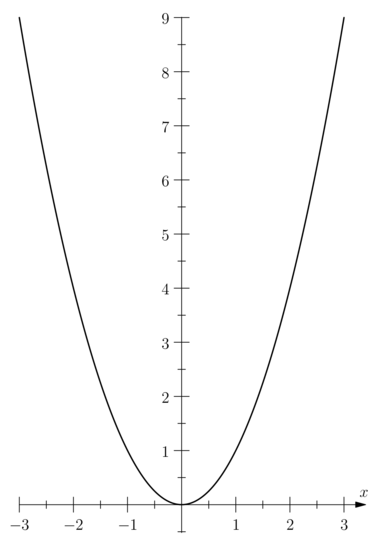
|
import graph; size(10cm,0); real xmin=-3,xmax=3; real ymin=-1,ymax=9.5; // Définition de la fonction real f(real x) {return x^2;} // Tracé de la courbe path Cf=graph(f,xmin,xmax,n=400); draw(Cf,linewidth(1bp)); xaxis(Label("$x$",align=Align),xmax=3.4,Ticks(NoZero),Arrow); yaxis(Ticks(NoZero)); shipout(bbox(2mm,Fill(white))); |


|
import graph; size(10cm,0); real xmin=-4,xmax=4; real ymin=-2,ymax=10; // Définition de la fonction real f(real x) {return x^2;} // Construction de points sous forme de croix path Cf1=graph(f,xmin,xmax,n=16); marker cross=marker(scale(4)*rotate(45)*cross(4),1bp+red); cross.mark(Cf1); // Définition et construction de la courbe path Cf2=graph(f,xmin,xmax,n=400); draw(Cf2,linewidth(1bp)); ylimits(-2.5,10,Crop); xaxis(Label("$x$",position=EndPoint, align=NE), xmin=xmin,xmax=xmax, Ticks(scale(.7)*Label(align=E), NoZero, begin=false,beginlabel=false, end=false,endlabel=false, Step=1,step=.25, Size=1mm, size=.5mm, pTick=black,ptick=gray), Arrow); yaxis(Label("$y$",position=EndPoint, align=NE), ymin=ymin,ymax=ymax, Ticks(scale(.7)*Label(), NoZero, begin=false,beginlabel=false, end=false,endlabel=false, Step=1,step=.25, Size=1mm, size=.5mm, pTick=black,ptick=gray), Arrow); shipout(bbox(2mm,Fill(white))); |


|
// Dans cet exemple, les points sont régulièrement espacés // sur la courbe mais ils ne correspondent plus nécessairement // à des abscisses entières ou semi-entières. import graph; size(10cm,0); real xmin=-4,xmax=4; real ymin=-2,ymax=10; // Définition de la fonction real f(real x) {return x^2;} marker croix=marker(scale(4)*rotate(45)*cross(4),markuniform(21),1bp+red); // Définition et construction de la courbe draw(graph(f,xmin,xmax,n=400),linewidth(1bp),croix); ylimits(-2.5,10,Crop); xaxis(Label("$x$",position=EndPoint, align=NE), xmin=xmin,xmax=xmax, Ticks(scale(.7)*Label(align=E), NoZero, begin=false,beginlabel=false, end=false,endlabel=false, Step=1,step=.25, Size=1mm, size=.5mm, pTick=black,ptick=gray), Arrow); yaxis(Label("$y$",position=EndPoint, align=NE), ymin=ymin,ymax=ymax, Ticks(scale(.7)*Label(), NoZero, begin=false,beginlabel=false, end=false,endlabel=false, Step=1,step=.25, Size=1mm, size=.5mm, pTick=black,ptick=gray), Arrow); shipout(bbox(2mm,Fill(white))); |


|
import graph; unitsize(1cm,.5cm); real xmin=-4,xmax=4; real ymin=-2,ymax=10; // Définition de la fonction real f(real x) {return x^2;} // Tracé de la courbe path Cf=graph(f,xmin,xmax,n=400); draw(Cf,linewidth(1bp)); xlimits(-4.5,4.5,Crop); ylimits(-2.5,10,Crop); xaxis(Label("$x$",position=EndPoint, align=NE), xmin=xmin,xmax=xmax, Ticks(scale(.7)*Label(align=E), NoZero, begin=false,beginlabel=false, end=false,endlabel=false, Step=1,step=.25, Size=1mm, size=.5mm, pTick=blue,ptick=gray), Arrow); yaxis(Label("$y$",position=EndPoint, align=NE), ymin=ymin,ymax=ymax, Ticks(scale(.7)*Label(), NoZero, begin=false,beginlabel=false, end=false,endlabel=false, Step=1,step=.5, Size=1mm, size=.5mm, pTick=blue,ptick=gray), Arrow); shipout(bbox(1cm,Fill(white))); |


|
import graph_pi; usepackage("mathrsfs"); size(10cm,0); graphicrules(xunit=1cm, yunit=1cm, xmin=-4, xmax=4, ymin=-2, ymax=10, crop=Crop ); grid(xStep=1, xstep=.5, yStep=1, ystep=.5, pTick=.8red, ptick=dotted+.7bp+.4white, above=false ); cartesianaxis( p=currentpen, xticks=RightTicks(Label(currentpen+fontsize(8), Fill(white)), Step=2, NoZero, pTick=.5mm+blue,ptick=grey), yticks=RightTicks(Label(currentpen+fontsize(8), align=NE), Step=2, NoZero, pTick=.5mm+blue,ptick=grey), viewxaxis=true, viewyaxis=true, above=true, arrow=Arrow ); labeloij(p=1.4bp+.5*red, arrow=Arrow(SimpleHead,8bp), dot ); // Définition de la fonction real f(real x) {return x^2;} // Tracé de la courbe path Cf=graph(f,n=400); draw(Cf,linewidth(1bp)); xlimits(-4.5,4.5,Crop); ylimits(-2.5,10.5,Crop); label("$\mathscr{C}_f$",(3,f(3)),NW); |

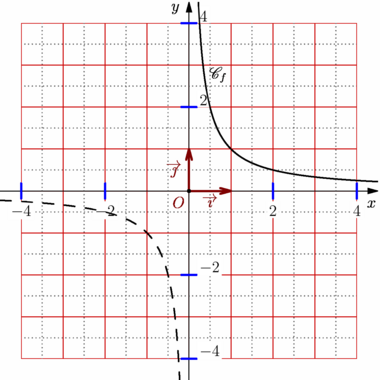
|
import graph_pi; usepackage("mathrsfs"); size(10cm,0); graphicrules(xunit=1cm, yunit=1cm, xmin=-4, xmax=4, ymin=-4, ymax=4, crop=Crop ); grid(xStep=1, xstep=.5, yStep=1, ystep=.5, pTick=.8red, ptick=dotted+.7bp+.4white, above=false ); cartesianaxis( p=currentpen, xticks=Ticks(Label(Fill(white)), Step=2, NoZero, pTick=.5mm+blue,ptick=grey), yticks=Ticks(Label(Fill(white), align=NE), Step=2, NoZero, pTick=.5mm+blue,ptick=grey), viewxaxis=true, viewyaxis=true, above=true, arrow=Arrow ); labeloij(p=1.4bp+.5*red, arrow=Arrow(SimpleHead,8bp), dot ); // Définition de la fonction real f(real x) {return 1/x;} // Tracé de la courbe path Cf1=graph(f,-5,-0.001,n=200); path Cf2=graph(f,0.001,5,n=200); draw(Cf1,dashed+1bp); draw(Cf2,linewidth(1bp)); xlimits(-4.5,4.5,Crop); ylimits(-4.5,4.5,Crop); label("$\mathscr{C}_f$",(.4,f(.4)),NE); |

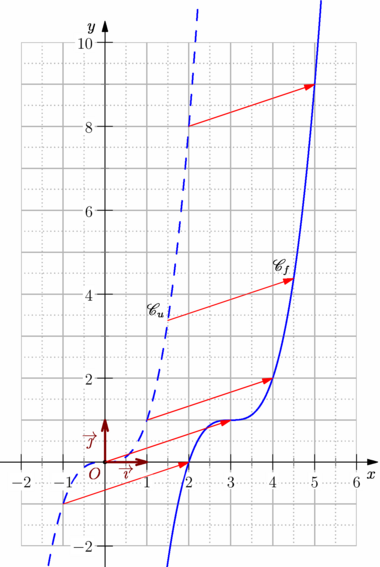
|
import graph_pi; import patterns; usepackage("mathrsfs"); size(10cm,0); graphicrules(xunit=1cm, yunit=1cm, xmin=-2, xmax=6, ymin=-2, ymax=10, crop=Crop ); // Définition et tracé de la grille grid(xStep=1, xstep=.5, yStep=1, ystep=.5, pTick=.7bp+.7white, ptick=.7bp+dotted+.7white, above=false ); // Définition et tracé des axes cartesianaxis( xticks=Ticks(Label(Fill(white)), Step=1, step=.5, NoZero, ptick=grey), yticks=Ticks(Label(Fill(white)), Step=2, step=1, NoZero, ptick=grey), Arrow ); real a=3, b=1; // Définition des fonctions real u(real x) {return x^3;} real f(real x) {return u(x-a)+b;} // voir exemple suivant pour une variante // Tracé des courbes path Cu=graph(u,-2,3,n=400); path Cf=graph(f,-2+a,3+a,n=400); draw(Cu,linewidth(1bp)+dashed+blue); draw(Cf,linewidth(1bp)+blue); xlimits(-2.5,7,Crop); ylimits(-2.5,11,Crop); // Ajout des noms de courbes, d'un repère. label("$\mathscr{C}_u$",(1.5,u(1.5)),NW); label("$\mathscr{C}_f$",(1.5+a,f(1.5+a)),NW); labeloij(p=1.4bp+.5*red, arrow=Arrow(SimpleHead,8bp), dot ); // Des réprésentants du vecteur de la translation for(int k=-1; k<3; ++k) draw((k,u(k))--(k+3,f(k+3)),red,Arrow); real k=1.5; draw((k,u(k))--(k+3,f(k+3)),red,Arrow); |


|
// Une variante de l'exemple précédent // où, cette fois, plutôt que de définir la fonction f // on définit une translation t que l'on exploite // pour les constructions. import graph_pi; import patterns; usepackage("mathrsfs"); size(10cm,0); graphicrules(xunit=1cm, yunit=1cm, xmin=-2, xmax=6, ymin=-2, ymax=10, crop=Crop ); // Définition et tracé de la grille grid(xStep=1, xstep=.5, yStep=1, ystep=.5, pTick=.7bp+.7white, ptick=.7bp+dotted+.7white, above=false ); // Définition et tracé des axes cartesianaxis( xticks=Ticks(Label(Fill(white)), Step=1, step=.5, NoZero, ptick=grey), yticks=Ticks(Label(Fill(white)), Step=2, step=1, NoZero, ptick=grey), Arrow ); // On définit une translation t de vecteur (a,b) real a=3, b=1; transform t=shift(a,b); // Définition de la fonction u et de sa courbe real u(real x) {return x^3;} path Cu=graph(u,-2,3,n=400); // La courbe Cf s'en déduit par la translation t path Cf=t*Cu; // On trace les courbes. draw(Cu,linewidth(1bp)+dashed+blue); draw(Cf,linewidth(1bp)+blue); xlimits(-2.5,7,Crop); ylimits(-2.5,11,Crop); // Ajout des noms de courbes, d'un repère. real k=1.5; label("$\mathscr{C}_u$",(k,u(k)),NW); label("$\mathscr{C}_f$",t*(k,u(k)),NW); labeloij(p=1.4bp+.5*red, arrow=Arrow(SimpleHead,8bp), dot ); // Des réprésentants du vecteur de la translation for(int k=-1; k<3; ++k) draw((k,u(k))--t*(k,u(k)),red,Arrow); k=1.5; draw((k,u(k))--t*(k,u(k)),red,Arrow); |

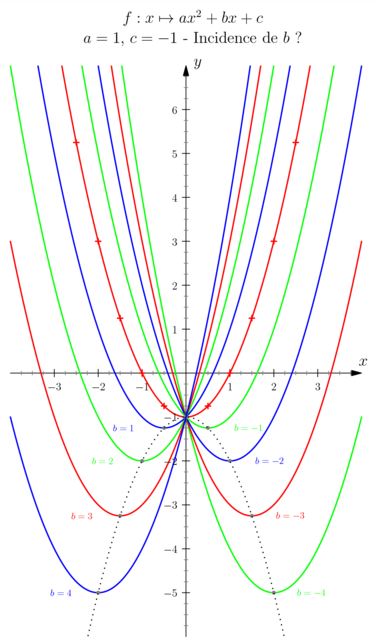
|
import graph; size(10cm,0); real xmin=-4,xmax=4; real ymin=-6,ymax=7; real a=1, b, c=-1; pen[] couleurs={red,blue,green}; // Définition de la fonction real f(real x) {return a*x^2+b*x+c;} // Construction de points sous forme de croix path Cf1=graph(f,xmin,xmax,n=16); marker cross=marker(scale(2)*rotate(45)*cross(4),1bp+red); cross.mark(Cf1); // Définition et construction de la famille de paraboles for(int b=-4;b<5;++b){ real f(real x) {return a*x^2+b*x+c;} path Cf2=graph(f,xmin,xmax,n=400); draw(Cf2,linewidth(1bp)+couleurs[b%couleurs.length]); dot((-b/2a,f(-b/2a)),3bp+gray); if(b!=0) label(scale(.6)*format("$b=%i$",b),(.95(-b/2a-sgn(a*b)),f(-b/2a)), couleurs[b%couleurs.length]); } // Définition et construction de la parabole des sommets real g(real x) {return c-a*x^2;} path Cg=graph(g,xmin,xmax,n=400); draw(Cg,linewidth(1bp)+dotted); ylimits(ymin,ymax,Crop); xaxis(Label("$x$",position=EndPoint, align=NE), xmin=xmin,xmax=xmax, Ticks(scale(.7)*Label(align=E), NoZero, begin=false,beginlabel=false, end=false,endlabel=false, Step=1,step=.25, Size=1mm, size=.5mm, pTick=black,ptick=gray), Arrow); yaxis(Label("$y$",position=EndPoint, align=NE), ymin=ymin,ymax=ymax, Ticks(scale(.7)*Label(), NoZero, begin=false,beginlabel=false, end=false,endlabel=false, Step=1,step=.25, Size=1mm, size=.5mm, pTick=black,ptick=gray), Arrow); label("$a=1$, $c=-1$ - Incidence de $b$ ?",truepoint(N),N); label("$f:x\mapsto ax^2+bx+c$",truepoint(N),N); shipout(bbox(2mm,Fill(white))); |

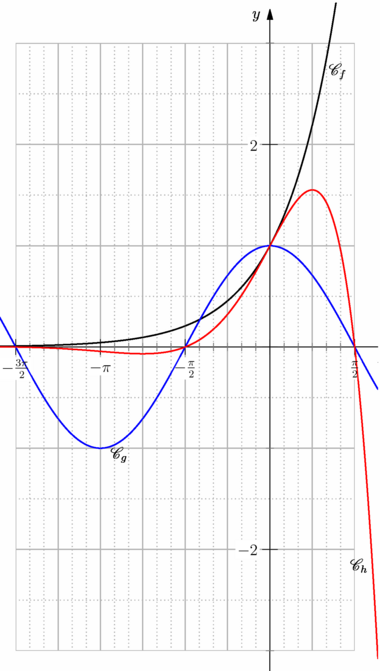
|
import graph_pi; usepackage("mathrsfs"); size(10cm,0); graphicrules(xunit=.8cm, yunit=1.5cm, xmin=-3pi/2, xmax=pi/2, ymin=-3, ymax=3, crop=Crop ); // Définition et tracé de la grille grid(xStep=pi/4, xstep=pi/12, yStep=1, ystep=.5, pTick=.7bp+.7white, ptick=.7bp+dotted+.7white, above=false ); // Définition et tracé des axes cartesianaxis( xticks=Ticks(Label(Fill(white)), labelfrac(factor=pi, symbol="\pi", symbolin=true, zero=false), Step=pi/2, step=pi/12, ptick=grey), yticks=Ticks(Label(Fill(white)), labelfrac(zero=false), Step=2, step=1, ptick=grey), Arrow ); // Définition des fonctions real f(real x) {return exp(x);} real g(real x) {return cos(x);} real h(real x) {return f(x)*g(x);} // Tracé des courbes path Cf=graph(f,-7,2,n=400); path Cg=graph(g,-7,2,n=400); path Ch=graph(h,-7,2,n=400); draw(Cf,linewidth(1bp)); draw(Cg,linewidth(1bp)+blue); draw(Ch,linewidth(1bp)+red); xlimits(-5,2,Crop); ylimits(-3.2,3.4,Crop); label("$\mathscr{C}_f$",(1,f(1)),E); label("$\mathscr{C}_g$",(-2.8,g(-2.8)),S); label("$\mathscr{C}_h$",(1.9,h(1.9)),W); |


|
import graph; unitsize(1cm); real xmin=-4,xmax=4; real ymin=-4,ymax=4; real f(real x) {return log((3+x)/(3-x));} marker cross=marker(scale(4)*rotate(45)*cross(4),1bp+red); cross.mark(graph(f,-2.5,2.5,n=10)); draw(graph(f,-2.99,2.99,n=400),linewidth(1bp)); ylimits(-5,5,Crop); xaxis(Label("$x$",position=EndPoint, align=NE), xmin=xmin,xmax=xmax, Ticks(scale(.7)*Label(align=E), NoZero, begin=false,beginlabel=false, end=false,endlabel=false, Step=1,step=.25, Size=1mm, size=.5mm, pTick=black,ptick=gray), Arrow); yaxis(Label("$y$",position=EndPoint, align=NE), ymin=ymin,ymax=ymax, Ticks(scale(.7)*Label(), NoZero, begin=false,beginlabel=false, end=false,endlabel=false, Step=1,step=.25, Size=1mm, size=.5mm, pTick=black,ptick=gray), Arrow); real a=-2.95; label("$f:x\mapsto\displaystyle\ln\left(\frac{3+x}{3-x}\right)$",(a,f(a)),E); |

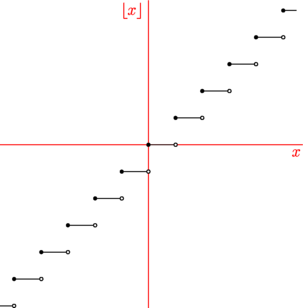
|
usepackage("amsmath"); import graph; size(8cm,0); real Floor(real x) {return floor(x);} pair[] ListeDesPointsCompris; pair[] ListeDesPointsExclus; //================== // bool3 est un booléen à trois états : true, default et false bool3 TestRelierOuPas(real x) { static real lasty; static bool first = true; real y = floor(x); bool memebranche = first || lasty == y; first = false; if(!memebranche) { ListeDesPointsExclus.push((x,lasty)); ListeDesPointsCompris.push((x,y)); } lasty=y; return memebranche ? true : default; }; //================== draw(graph(Floor,-5.5,5.5,500,TestRelierOuPas)); axes("$x$",rotate(0)*"$\lfloor x\rfloor$",red); dot(ListeDesPointsCompris); dot(ListeDesPointsExclus,UnFill); |

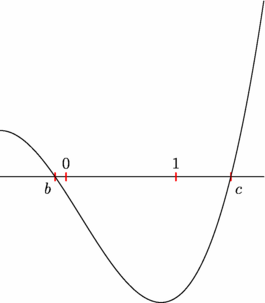
|
import graph; size (7cm,0); real a=-1, b=-.1, c=1.5; real f(real x) {return (x-a)*(x-b)*(x-c);} draw(graph(f,b-.5,c+.3)); xaxis (Ticks("%", new real[]{a,b,0,1,c},Size=1mm,1bp+red)); labelx("$b$",b,SW); labelx(0,1.5N); labelx(1,1.5N); labelx("$c$",c,SE); |


|
import graph_pi; import patterns; usepackage("mathrsfs"); size(10cm,0); graphicrules(xunit=1cm, yunit=1cm, xmin=-2, xmax=4, ymin=-1, ymax=5 //,crop=Crop ); // Définition et tracé de la grille grid(xStep=1, xstep=.5, yStep=1, ystep=.5, pTick=.7bp+.7white, ptick=.7bp+dotted+.7white, above=false ); // Définition et tracé des axes cartesianaxis( xticks=Ticks(Label(Fill(white)), Step=1, step=.5, NoZero, ptick=grey), yticks=Ticks(Label(Fill(white)), Step=2, step=1, NoZero, ptick=grey), Arrow ); // Définition de la fonction real f(real x) {return 4-(x-1)^2;} // Les hachures. path zonehachuree=buildcycle((3,0)--(0,0)--(0,3),graph(f,0,3)); add("hachure",hatch(H=3mm,dir=NE,red)); fill(zonehachuree,pattern("hachure")); // Tracé de courbe path Cf=graph(f,-3,5,n=400); draw(Cf,linewidth(1bp)+blue); xlimits(-2.5,4.5,Crop); ylimits(-1.5,5.5,Crop); label("$\mathscr{C}_f$",(1,f(1)),NE); labeloij(p=1.4bp+.5*red, arrow=Arrow(SimpleHead,8bp), dot ); |


|
import graph_pi; import patterns; usepackage("mathrsfs"); size(10cm,0); graphicrules(xunit=1cm, yunit=1cm, xmin=-1, xmax=4, ymin=-3, ymax=3 //, crop=Crop ); // Définition et tracé de la grille grid(xStep=1, xstep=.5, yStep=1, ystep=.5, pTick=.7bp+.7white, ptick=.7bp+dotted+.7white, above=false ); // Définition et tracé des axes cartesianaxis( xticks=Ticks(Label(Fill(white)), Step=1, step=.5, NoZero, ptick=grey), yticks=Ticks(Label(Fill(white)), Step=2, step=1, NoZero, ptick=grey), Arrow ); // Définition des fonctions real f(real x) {return 2x-x^2;} real g(real x) {return x;} // Les hachures. path zonehachuree=buildcycle(graph(f,0,3),(3,-5)--(3,5),graph(g,3,0)); add("hachure",hatch(H=1mm,dir=SE,lightgray)); fill(zonehachuree,pattern("hachure")); // Tracé de courbe path Cf=graph(f,-1.5,4.5,n=400); path Cg=graph(g,-1.5,4.5,n=400); draw(Cf,1bp+blue); draw(Cg,dashed+1bp+red); xlimits(-1.5,4.5,Crop); ylimits(-3.5,3.5,Crop); label("$\mathscr{C}_f$",(2.5,f(2.5)),SW,blue); label("$\mathscr{C}_g$",(2.5,g(2.5)),NW,red); labeloij(p=1.4bp+.5*red, arrow=Arrow(SimpleHead,8bp), dot ); |


|
// OG.asy est, comme son nom l'indique, un fichier de contributions d'O.G.. // téléchargeable ici : OG.asy import graph; import OG; // pour profiter de "Bras" : extrémités de segment en forme de crochets. size(8cm,0); real f (real x) { return cos(x); } ylimits(-.3,1.5); xaxis("$x$",EndArrow); yaxis("$y$",EndArrow); draw(graph(f,-.5,2,operator ..)); real x0=1; real delta=.4; path hline1=(x0-delta,0)--graph(f,x0-delta,x0+delta)--(x0+delta,0)--cycle, hline2=(0,f(x0-delta))--graph(f,x0-delta,x0+delta)--(0,f(x0+delta))--cycle; fill(hline1^^hline2,palegreen+opacity(.95)); draw(hline1^^hline2,blue); draw((x0-delta,0)--(x0+delta,0),blue+bp,Bras); // draw((0,f(x0+delta))--(0,f(x0-delta)),blue+bp,Bras); draw(graph(f,x0-delta,x0+delta),1.5bp+red,Bras); |


|
import graph; size (8cm,0); real f(real x) {return (x^3-3x^2-x+2)/3;} path Cf=graph(f,-1.6,3.5); draw(Cf); // real dirtime(path p, pair z); // returns the first "time", a real number between 0 and the length of // the path in the sense of point(path, real), at which the tangent // to the path has the direction of pair z, or -1 if this never happens. real tA=dirtime(Cf,(1,0)); // le "time" du premier point du path // dont la tangente est dans la direction (1,0). pair pA=point(Cf,tA); // et le point correspondant du path dot(pA,4bp+red); // que l'on dessine en rouge. // on procède de la même manière avec le path orienté dans l'autre sens // pour trouver le second point bleu. real tB=dirtime(reverse(Cf),(-1,0)); pair pB=point(reverse(Cf),tB); dot(pB,4bp+blue); draw(pA--pA+(1,0),grey,Arrow); draw(pB--pB+(-1,0),grey,Arrow); xaxis(Label("$x$",position=EndPoint, align=NE), Ticks(scale(.7)*Label(),NoZero,Size=.8mm, size=.4mm)); yaxis(Label("$y$",position=EndPoint, align=NE), Ticks(scale(.7)*Label(),NoZero,Size=.8mm, size=.4mm)); label("Utilisation de dirtime",truepoint(SE),NW); |


|
import graph; size (8cm,0); real f(real x) {return (x^3-3x^2-x+2)/3;} path Cf=graph(f,-1.6,3.5); draw(Cf); // real dirtime(path p, pair z); // returns the first "time", a real number between 0 and the length of // the path in the sense of point(path, real), at which the tangent // to the path has the direction of pair z, or -1 if this never happens. real tA=dirtime(Cf,(1,0)); // le "time" du premier point du path // dont la tangente est dans la direction (1,0). pair pA=point(Cf,tA); // et le point correspondant du path dot(pA,4bp+red); // que l'on dessine en rouge. // On définit le path correspondant à la partie de Cf débutant au point rouge. path Cf2=subpath(Cf,tA,reltime(Cf,1)); // Une autre façon de trouver le point bleu avec la fonction : // real[] mintimes(path p) // returns an array of length 2 containing times at which path p // reaches its minimal horizontal and vertical extents, respectively. pair pB=point(Cf2,mintimes(Cf2)[1]); draw(Cf2,1bp+red); dot(pB,4bp+blue); draw(pA--pA+(1,0),grey,Arrow); xaxis(Label("$x$",position=EndPoint, align=NE), Ticks(scale(.7)*Label(),NoZero,Size=.8mm, size=.4mm)); yaxis(Label("$y$",position=EndPoint, align=NE), Ticks(scale(.7)*Label(),NoZero,Size=.8mm, size=.4mm)); label("dirtime/reltime/mintimes",truepoint(SE),NW); |

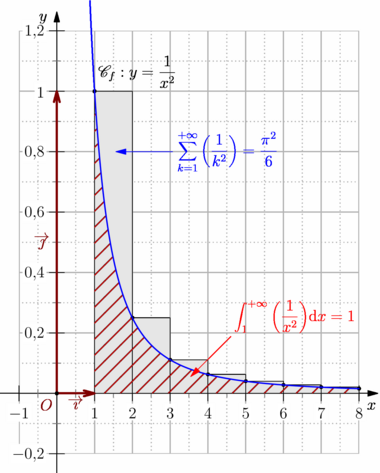
|
import graph_pi; import patterns; usepackage("mathrsfs"); usepackage("icomma"); size(10cm,0); graphicrules(xunit=1cm, yunit=8cm, xmin=-1, xmax=8, ymin=-.2, ymax=1.2, crop=Crop ); // Définition et tracé de la grille grid(xStep=1, xstep=.5, yStep=.2, ystep=.1, pTick=.7bp+.7white, ptick=.7bp+dotted+.7white, above=false ); // Définition et tracé des axes cartesianaxis( xticks=Ticks(Label(Fill(white)), Step=1, step=.5, NoZero, ptick=grey), yticks=Ticks(Label(Fill(white)), Step=.2, step=.1, NoZero, ptick=grey), Arrow ); // Définition de la fonction real f(real x) {return 1/x^2;} // Les rectangles int a=1, b=8; for(int i=a; i <= b; ++i) { if(i < b) filldraw(box((i,f(i)),(i+1,0)),lightgray); dot((i,f(i))); } // Les hachures. path zonehachuree=buildcycle((8,1)--(8,0)--(1,0)--(1,1),graph(f,1,8)); add("hachure",hatch(H=3mm,dir=NE,red)); fill(zonehachuree,pattern("hachure")); // Tracé de courbe path Cf=graph(f,.5,8,n=400); draw(Cf,linewidth(1bp)+blue); xlimits(-1.5,8.5,Crop); ylimits(-.3,1.3,Crop); label("$\mathscr{C}_f : y=\displaystyle\frac{1}{x^2}$",(1,f(1)),NE); labeloij(p=1.4bp+.5*red, arrow=Arrow(SimpleHead,8bp), dot ); arrow("$\displaystyle\int_{1}^{+\infty}\left(\frac{1}{x^2}\right)$d$x=1$", (3.5,0.05),NE,1.5cm,red,Margin(0,0.5)); arrow("$\displaystyle\sum_{k=1}^{+\infty}\left(\frac{1}{k^2}\right) =\frac{\pi^2}{6}$",(1.5,0.8),E,1.5cm,blue,Margin(0,0.5)); |

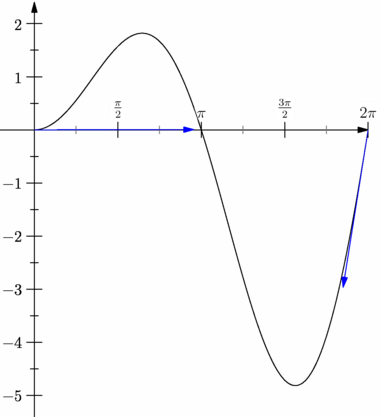
|
import base_pi; // base_pi téléchargeable ici : base_pi de Ph.Ivaldi // extension utilisée pour texfrac : permettant de graduer l'axe des // abscisses en fonction de pi. import graph; size(10cm,0); real f(real x) { return x*sin(x); } path Cf=graph(f,0,2pi,n=4000); // 4000 pour des tangentes plus précises. draw(Cf); xaxis(Ticks(Label(align=W,Fill(white)),NoZero, ticklabel = new string(real x){return texfrac(rational(x/pi), factor="\pi");}, Step=pi/2, step=pi/4, ptick=grey),Arrow); yaxis(ymin=-5.4,ymax=2.4,Ticks(NoZero),Arrow); // Les deux tangentes... avec une méthode spécifique au fait // qu'elles sont en deux points simples : // celui de début et celui de fin de path fin de "path". pair pA=relpoint(Cf,0), pB=relpoint(Cf,1); draw(pA--pA+3*dir(Cf,0),blue,Arrow); draw(pB--pB-3*dir(Cf,length(Cf)),blue,Arrow); |

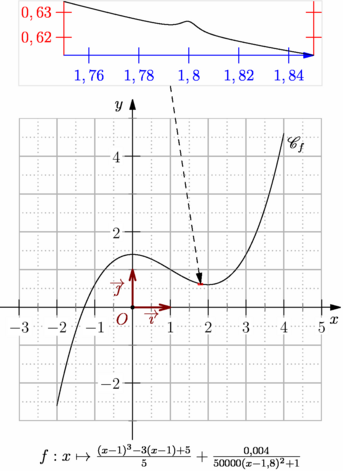
|
import graph_pi; usepackage("mathrsfs"); unitsize(1cm,0); pen pointille=linetype("0 " + string(1mm), offset=0, scale=false, adjust=false); real f(real x) {return ((x-1)**3-3*(x-1)+5)/5+0.004/(50000*(x-1.8)**2+1);} pair F(real x) {return (x,f(x));} graphicrules(xunit=1cm, yunit=1cm, xmin=-3, xmax=5, ymin=-3, ymax=5, crop=Crop ); grid(xStep=1, xstep=.5, yStep=1, ystep=.5, pTick=.7bp+.7white, ptick=.7bp+pointille+.7white, above=false ); // Définition et tracé des axes cartesianaxis( xticks=Ticks(Label(Fill(white)), Step=1, step=.5, NoZero, ptick=grey), yticks=Ticks(Label(Fill(white)), Step=2, step=1, NoZero, ptick=grey), Arrow ); draw(graph(f,-2,4,1000)); label("$\mathscr{C}_f$",F(4),SE); xlimits(-3.5,5.5,Crop); ylimits(-3.5,5.5,Crop); labeloij(p=1.2bp+.5*red, arrow=Arrow(SimpleHead,8bp), dot ); picture pic; size(pic,8cm); draw(pic,graph(pic,f,1.75,1.85,1000)); xaxis(pic,Bottom(),xmin=1.75,xmax=1.85,blue,Ticks(Step=0.02),Arrow); yaxis(pic,LeftRight(),red,Ticks(Step=0.01)); add(new void(frame f, transform t) { frame G=shift(point(f,N))*align(bbox(pic,lightgray),10N); add(f,G); draw(f,t*box(min(pic,user=true),max(pic,user=true)),red); draw(f,point(G,S)--t*point(pic,N),dashed,Arrow); }); label("$f:x\mapsto \frac{(x-1)^3-3(x-1)+5}5+\frac{0,004}{50000(x-1,8)^2+1}$",truepoint(S),S); |
Dernière modification le Wed Sep 11 15:36:28 CEST 2013 par G.Marris Valide XHTML